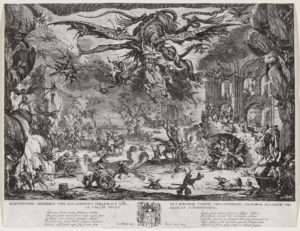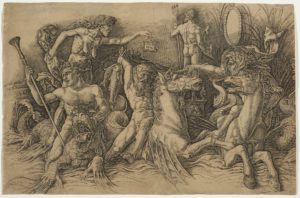It occurs to me, as I walk through the new exhibition on monsters at the National Gallery, that while we always fear monsters, what we fear as monsters changes as we shuffle along the trajectory from birth to death.
Lurking beneath the beds of children, or flying out of dark clouds overhead, are creatures of fantastical danger, truly terrible freaks of nature. Then we’re adults, and monsters tend to take more human form, in the monstrous acts committed by the most inhumanely depraved people. The gallery’s exhibition has plenty of both types, monsters that look like dragons, and monsters that look disconcertingly human.

Hendrick Goltzius. The Dragon Devouring the Companions of Cadmus, 1588. Engraving on cream laid paper 25.5 × 32 cm. National Gallery of Canada. Purchased 2019. Photo: NGC
Beautiful Monsters in Early European Prints and Drawings (1450-1700) has a lot of what might be expected (the exhibition is dominated by the work of Albrecht Dürer) and some surprises (an atypical work by M.C. Escher). Close to 70 pieces make for a malignant menagerie. The words “gruesome” and “grotesque” appear more frequently than in most exhibitions.
It’s organized in four categories — mythological creatures, sea monsters, ornamental beasts and, of course, demons. It’s the last group that most disturbs me, as demons often look too human.
Dürer’s The Knight, Death and the Devil, for example, has figures that look both humanoid and horrible. It also demonstrates how influential these old drawings are, as the Knight and Death bear a strong resemblance to the ring wraiths of Tolkien’s Middle Earth. It’s evident that this era of art is the template for many of the monsters that still dominate popular culture. (Another surprise: Curator Sonia del Re points to a seven-headed serpent and suggests those heads look like the creatures of Dr. Seuss. She’s right, unfortunately, so I’ll now be more wary about with whom I eat green eggs and ham.)

Jacques Callot. The Temptation of Saint Anthony (second version), 1635. Etching on laid paper, 35.6 × 46.2 cm. National Gallery of Canada. Purchased 1993. Photo: NGC
Many of the works are engravings and etchings and the detail is intense. In three views of Descent into Hell, by Dürer and the School of Andrea Mantegna, that dreadful voyage is rendered in relentless detail, from the anguish of the humans to the delight of the hovering demons. Even more lushly detailed are Claude Gillot’s four scenes from the life of the Satyrs, including birth, education, marriage and funeral.
At times that world of detail is crammed into the tiniest spaces. Hans Sebald Beham engraved Two Genii Riding on Two Chimeras onto a slip of paper perhaps an inch high and four inches wide. Rarer still is Homage to Venus, a tiny, circular work by an unknown artist from the mid-15th century — the only example of niello engraving in the gallery’s collection, Del Re says.
The nature and appearance of monsters often reflect the moral and social anxieties of the time, some of them still relevant, such as “the power dynamics of religion and gender.” In Jacques Callot’s The Temptation of St. Anthony, the saint courageously resists as he’s assailed by demons. In another, brave Hercules drives away the harpies, those winged, feline mutations of human females.
Elsewhere, that adjective “gruesome” gets heavy play. In Phillipe Galle’s The Triumph of Time, Saturn — who never got a “World’s Best Dad” mug for Father’s Day — chews on the haunch of one of his own children. In Hendrick Goltzius’s The Dragon Devouring the Companions of Cadmus, the dragon is biting the face off a man in a most uncompanionable fashion.

Andrea Mantegna. Battle of the Sea Gods (left side), c. 1485–88. Engraving on laid paper, 28 × 42.7 cm. National Gallery of Canada. Purchased 1915. Photo: NGC
At the back of it all — leading, appropriately, to another gallery full of surreal works — is the piece by M.C. Escher, which stands out for more than one reason. It was created in the 20th century, anywhere from 300 to 500 years after the other works, and it’s a scene of Hell done “after Hieronymus Bosch”. Escher created it after seeing Bosch’s turn-of-the-16th century masterpiece The Garden of Earthly Delights.
At the other end of the room is a work that perhaps best exemplifies the “Beautiful Monsters” of the exhibition title. It’s a sculpture of St. George fighting the dragon, done in silver and gilded bronze c. 1700 and attributed to an artist known only as Master of the Bull Hunt. From any angle it’s a glorious work, with St. George astride his mighty steed, his spear raised to plunge into the chest of the supine dragon, the rescued princess standing aside, her silver hair blowing over her bronze cloak.
I couldn’t help but to think of England today, and the battle of the great beast of Brexit. Centuries later and still, there be dragons.
Beautiful Monsters continues to March 29.






